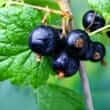Background
- The black currant shrub is native to Europe and parts of Asia and is particularly popular in Eastern Europe and Russia. Traditional herbalists uphold that black currant has diuretic (increases urine flow), diaphoretic (promotes sweating), and antipyretic (fever reducer) properties. In Europe, it has been used topically (applied to the skin) to treat skin disorders, such as atopic dermatitis, and as part of gargles to treat sore throats. Black currant juice has been boiled down into a sugary extract, called Rob, to treat sore throat inflammation, colds, the flu, and febrile (fever) illness. A mixture made from black currant bark has been used to treat calculus (hardened plaque), edema (swelling), and hemorrhoids.
- With a vitamin C content estimated to be five times that of oranges (2,000 milligrams/kilogram), black currant has potential dietary benefits. Black currant is also rich in rutin and other flavonoids, which are known antioxidants. Because of black currant's high essential fatty acid content, researchers believe that it may be effective in the treatment of inflammatory conditions and pain management, as well as in regulating the circulatory system and increasing immunity.
- As a medicinal treatment, black currant seed oil is the most commonly used part of the plant and is available in capsule form. The effectiveness of black currant seed oil is mixed and safety concerns seem to be minor in non-allergic people.
References
Natural Standard developed the above evidence-based information based on a thorough systematic review of the available scientific articles. For comprehensive information about alternative and complementary therapies on the professional level, go to . Selected references are listed below.
- Bitsch I, Janssen M, Netzel M, et al. Bioavailability of anthocyanidin-3-glycosides following consumption of elderberry extract and blackcurrant juice. Int.J.Clin.Pharmacol.Ther. 2004;42(5):293-300.
View Abstract - Carmen Ramirez-Tortosa M, Garcia-Alonso J, Luisa Vidal-Guevara M, et al. Oxidative stress status in an institutionalised elderly group after the intake of a phenolic-rich dessert. Br J Nutr 2004;91(6):943-950.
View Abstract - Garbacki N, Angenot L, Bassleer C, et al. Effects of prodelphinidins isolated from Ribes nigrum on chondrocyte metabolism and COX activity. Naunyn Schmiedebergs Arch.Pharmacol. 2002;365(6):434-441.
View Abstract - Knox YM, Suzutani T, Yosida I, et al. Anti-influenza virus activity of crude extract of Ribes nigrum L. Phytother.Res. 2003;17(2):120-122.
View Abstract - Lengsfeld C, Deters A, Faller G, et al. High molecular weight polysaccharides from black currant seeds inhibit adhesion of Helicobacter pylori to human gastric mucosa. Planta Med. 2004;70(7):620-626.
View Abstract - Matsumoto H, Nakamura Y, Hirayama M, et al. Antioxidant activity of black currant anthocyanin aglycons and their glycosides measured by chemiluminescence in a neutral pH region and in human plasma. J.Agric.Food Chem. 8-28-2002;50(18):5034-5037.
View Abstract - Matsumoto H, Takenami E, Iwasaki-Kurashige K, et al. Effects of blackcurrant anthocyanin intake on peripheral muscle circulation during typing work in humans. Eur J Appl Physiol 2005;94(1-2):36-45.
View Abstract - Moller P, Loft S, Alfthan G, et al. Oxidative DNA damage in circulating mononuclear blood cells after ingestion of blackcurrant juice or anthocyanin-rich drink. Mutat.Res. 7-13-2004;551(1-2):119-126.
View Abstract - Mulleder U, Murkovic M, Pfannhauser W. Urinary excretion of cyanidin glycosides. J Biochem Biophys Methods 2002;53(1-3):61-66.
View Abstract - Nakaishi H, Matsumoto H, Tominaga S, et al. Effects of black current anthocyanoside intake on dark adaptation and VDT work-induced transient refractive alteration in healthy humans. Altern Med Rev 2000;5(6):553-562.
View Abstract - Netzel M, Strass G, Janssen M, et al. Bioactive anthocyanins detected in human urine after ingestion of blackcurrant juice. J.Environ.Pathol.Toxicol.Oncol. 2001;20(2):89-95.
View Abstract - Nielsen IL, Dragsted LO, Ravn-Haren G, et al. Absorption and excretion of black currant anthocyanins in humans and watanabe heritable hyperlipidemic rabbits. J.Agric.Food Chem. 4-23-2003;51(9):2813-2820.
View Abstract - Suzutani T, Ogasawara M, Yoshida I, et al. Anti-herpesvirus activity of an extract of Ribes nigrum L. Phytother.Res. 2003;17(6):609-613.
View Abstract - Tahvonen RL, Schwab US, Linderborg KM, et al. Black currant seed oil and fish oil supplements differ in their effects on fatty acid profiles of plasma lipids, and concentrations of serum total and lipoprotein lipids, plasma glucose and insulin. J Nutr Biochem 2005;16(6):353-359.
View Abstract - West NX, Hughes JA, Parker DM, et al. Development of low erosive carbonated fruit drinks 2. Evaluation of an experimental carbonated blackcurrant drink compared to a conventional carbonated drink. J.Dent. 2003;31(5):361-365.
View Abstract







